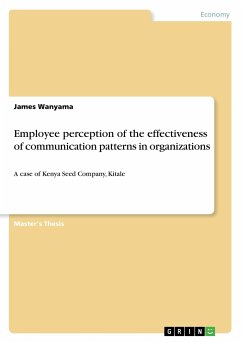Master's Thesis from the year 2016 in the subject Business economics - Personnel and Organisation, , course: MASTER OF PHILOSOPHY IN HUMAN RESOURCE DEVELOPMENT, language: English, abstract: A communication system links together the constituent parts of an organization and provides for the creation, distribution, interpretation and execution of instructions. The purpose of the study was to investigate employees' perception of the effectiveness of communication patterns used in organizations, establish employee use, evaluating and rating of the known patterns of communication, and how the known patterns are effective in service delivery.This study was guided by the kite orientation model (1973), which focuses on interpersonal communication on communication that is two-way and emphasizes on the dynamics of communication situations. Related literature on this model, Human Resource Management and relationship between communication patterns and Human Resource Management was reviewed.Survey research design was used and was carried out at Kenya Seed Company. There are over 300 employees from the departments of Human Resource, Public Relations, research and development, auditing and field, Marketing and Finance. Out of this, a sample of 180 which represented 60% from the whole population was selected using purposive and stratified sampling. Data was collected using questionnaires, observation and interview schedules. The data collected was then classified, presented, analyzed and interpreted through descriptive statistical techniques. The data was presented in the form of percentages and frequency tables.The findings were that employees perceived the use of communication patterns as ineffective, and the study further suggested that organizations should put in place structures that will improve communication between employees and management.The findings of the study will be useful to management of Kenya Seed Company as information will be provided as a benchmark toevaluate its communication patterns to enhance effectiveness in service delivery. The study will serve as an additional reference material for scholars interested in exploring the communication patterns as a broad aspect in the world and specifically in such organizations as Kenya Seed Company.








